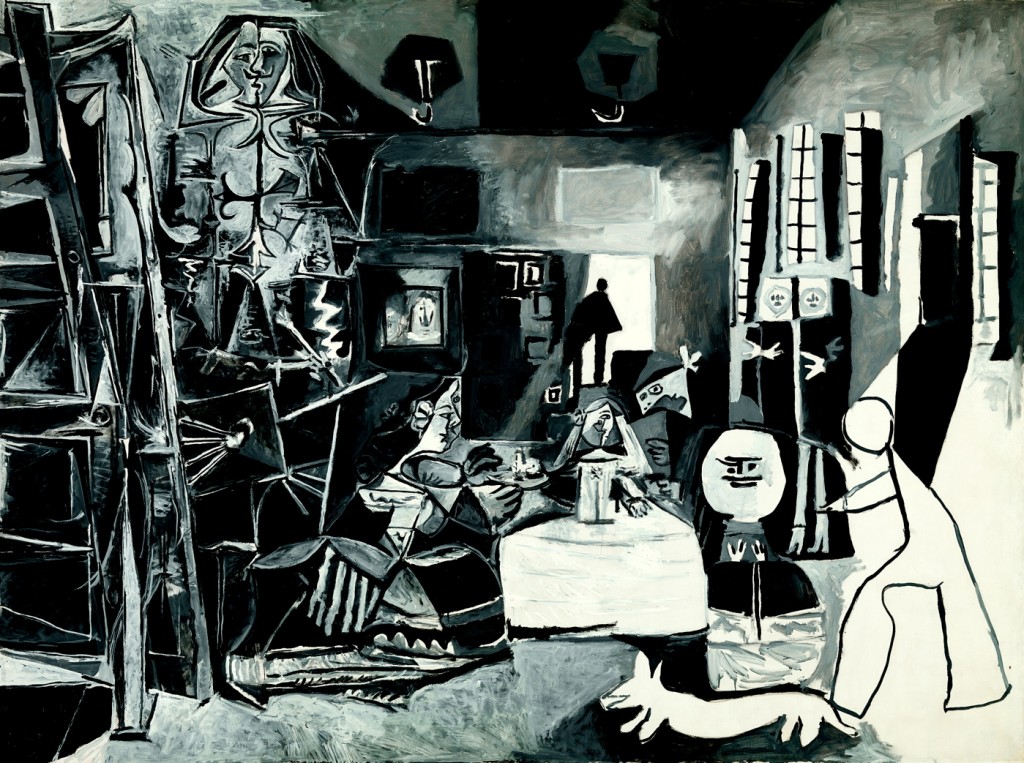
Contemporary artists rock art-history classics to pay homage, show off, have fun, and comment on issues like race and class
By Robin Cembalest Posted 10/10/12
Among the many delights of “Picasso Black and White,” which opened at the Guggenheim last week, was seeing how the Spanish master treated his elders. This is apparent not only in the ways he echoed his nation’s painterly tradition with his own austere palette, but also in his recapitulations–or, as some might say, appropriations–of multiple art-historical icons. Poussin’s Rape of the Sabine Women and Delacroix’s The Women of Algiers are among the pictures Picasso takes for a modernist spin, riffing on pointedly on their subject matter as he brashly updates their stye. And then there’s Las Meninas, the Velázquez masterpiece showing the royal family, their entourage, and the artist himself. In Picasso’s manic re-interpretation–or, some might say, misreading–from 1957, the painter has grown to be the biggest figure in the room.
 Pablo Picasso, The Maids of Honor (Las Meninas, after Velázquez) (Les Ménines, vue d’ensemble, d’après Velázquez), 1957, oil on canvas.
Pablo Picasso, The Maids of Honor (Las Meninas, after Velázquez) (Les Ménines, vue d’ensemble, d’après Velázquez), 1957, oil on canvas.
MUSEU PICASSO, BARCELONA, GIFT OF THE ARTIST, 1968/©2012 ESTATE OF PABLO PICASSO/ARTISTS RIGHTS SOCIETY (ARS), NEW YORK/PHOTO: GASSULL FOTOGRAFIA
For contemporary artists, quoting Old Masters is still an exercise, diversion, rite of passage, and vehicle for social and political commentary–showing that the great tradition of European painting still has its pull (or at least its uses) among the new avant-garde. Here are some examples that have popped up in recent shows:
Snake Eyes
The catalogue for Braco Dimitrijevic’s current show at Sperone Westwater is called “Between the Louvre and the Zoo,” but this encounter took place in the Kunsthalle Darmstadt.
 Braco Dimitrijevic, Slow as Light Fast as Thought, 1995, digital color print, edition of 5 and 3 AP.
Braco Dimitrijevic, Slow as Light Fast as Thought, 1995, digital color print, edition of 5 and 3 AP.
COURTESY SPERONE WESTWATER, NEW YORK.
Da Vinci Co-ed
In his recent show at Hasted Kraeutler, Ethiopia-born, Bronx-raised photographer Awol Erizku recapitulated masterworks using African American sitters with fabulous clothes and contemporary props. So Vermeer’s Girl with a Pearl Earring becomes Girl with a Bamboo Earring. And Leonardo’s fetching Lady with an Ermine, his much-interpreted 1496 portrait of the teenaged mistress of Duke Ludovico Sforza, is reimagined as modern-day beauty with a pit bull puppy.
She’s in the Monet
Monet’s gardens at Giverny, considered a sculpture in themselves, if not one of the first works of land art, remain strong in contemporary artist’s imaginations–in part because the Versailles Foundation brings contemporary creators to live and work there each year. That’s how E.V. Day ended up in the Impressionist setting, recreated at the Hole Gallery last spring. It was a collaboration with her friend Kembra Pfahler, artist and lead singer of the death-rock band The Voluptuous Horror of Karen Black, who traveled to Giverney to strike a few poses.
Venus in Sludge
There’s a lot more trash around than there was when Venus emerged from the sea in Botticelli’s Birth of Venus, so Vik Muniz’s version, in his current show at the Mint Museum, “Garbage Matters,” rises from a landfill–even as she is created of material from it.
 Vik Muniz, The Birth of Venus, after Botticelli (Pictures of Junk), 2008, digital chromogenic print.
Vik Muniz, The Birth of Venus, after Botticelli (Pictures of Junk), 2008, digital chromogenic print.
COURTESY SIKKEMA JENKINS GALLERY, NEW YORK CITY/©VIK MUNIZ/LICENSED BY VAGA, NEW YORK, NY.
Oh Captain?
Raft of the Medusa, Gericault’s influential history painting depicting victims of a notorious shipwreck, is a bit worse for the wear in Concordia, Concordia, Thomas Hirschhorn’s rendering of the Italian cruise ship that ran aground last year, now at Barbara Gladstone. The captains in both instances were blamed for their incompetence.
 Thomas Hirschhorn, Concordia, Concordia, 2012. Installation at Barbara Gladstone’s gallery on 21st Street.
Thomas Hirschhorn, Concordia, Concordia, 2012. Installation at Barbara Gladstone’s gallery on 21st Street.
PHOTO: ANNA KOWALSKA/©THOMAS HIRSCHHORN/COURTESY GLADSTONE GALLERY, NEW YORK AND BRUSSELS.
The Influence of Anxiety
In the catalogue for Kim Jones’s show of works on paper opening Friday at Pierogi, Kim Levin locates the origin of the artist’s Felliniesque hybrids– conjuring “boyhood fantasies merging with the actual experience of a veteran who has been in the hell of war”–in Tiepolo. But they also look like refugees from Goya’s Caprichos and contemporary caricature.
 Kim Jones, Untitled, 1972-2011, acrylic and ink on paper.
Kim Jones, Untitled, 1972-2011, acrylic and ink on paper.
COURTESY THE ARTIST AND PIEROGI.
Clothes Encounters
In his first show of female portrait subjects, earlier this year at Sean Kelly, Kehinde Wiley found his sitters on New York’s streets and dressed them in outfits designed by Givency’s Riccardo Tisci. The Honourable Mrs Graham (1757 – 1792), Thomas Gainsborough’s 1775 – 1777 portrait of a tragic beauty, inspired Wiley’s Mrs. Graham.
![KW-PA12-018 Mrs Graham[1]](https://www.artnews.com/wp-content/uploads/2012/10/KW-PA12-018-Mrs-Graham1.jpeg) Kehinde Wiley, Mrs. Graham, 2012, oil on canvas.
Kehinde Wiley, Mrs. Graham, 2012, oil on canvas.
©KEHINDE WILEY/SEAN KELLY GALLERY, NEW YORK.
Shock of the Old
The website for the Musée d’Orsay, where Courbet’s notorious 1866 Origin of the World is displayed, notes that the most famous portrait of a woman’s genitalia in art history had its roots in Titian, Veronese, Correggio and the tradition of carnal, lyrical painting. Mickalene Thomas’s version is one of several Courbet-inspired works in her show at the Brooklyn Museum.
 Mickalene Thomas, Origin of the Universe 2, 2012, rhinestones, acrylic, oil, and enamel on wood panel.
Mickalene Thomas, Origin of the Universe 2, 2012, rhinestones, acrylic, oil, and enamel on wood panel.
PRIVATE COLLECTION, NEW YORK/COURTESY THE ARTISTS AND LEHMANN MAUPIN GALLERY, NEW YORK.
Copyright 2012, ARTnews LLC, 48 West 38th St 9th FL NY NY 10018. All rights reserved.


